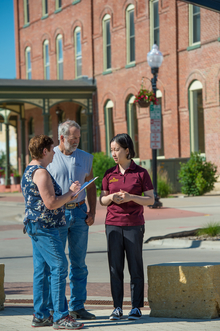New Tourism Center Director Xinyi Qian shares thoughts on challenges and opportunities.
The University of Minnesota Tourism Center helps guide local decision-making, inform policy and marketing strategies, and strengthen the economy through tourism. Xinyi Qian, Extension tourism specialist since 2013, was recently named director.
What are you looking forward to working on in the near future?
I was attracted to the Tourism Center by the type of work: conducting applied research that communities use to inform their decisions and strategies, supporting education that the industry needs to sustain itself, and the opportunities to work with different types of entities and professionals.
We can leverage the talent and resources of the University to help the tourism industry and communities address some of their most challenging issues, like workforce development, and realize big potential through growing outdoor recreation, for example.
Why should community leaders care about and invest in tourism?
Overarching societal trends affect the tourism industry just as much, if not more, than other sectors. For example, the lack of affordable housing plagues metropolitan, suburban and rural areas alike, and this translates into workforce shortages. Global supply chain issues exacerbated by the pandemic have also placed tremendous pressure on hotels, restaurants and other businesses.
Meanwhile, the tourism industry has a well-documented halo effect. Making your area more appealing to visitors through sports and recreation, arts and culture, shopping, and events turns out to be very attractive to potential new residents and businesses, too.
What topics and trends are you tracking for the Minnesota tourism industry in 2022?
COVID-19 continues to be a huge disruption, to say the least. Workforce shortages in the near term are being addressed with specialized training and educational programs, but it takes a while to develop that talent pipeline.
Second, climate change and adaptation are no longer future concerns. In just the past year, we’ve seen how wildfire and drought can have a huge impact on the tourism industry, and these events are predicted to become more frequent and intense. The need for resources and education in this area will only continue to grow.
Finally, data. There are so many new opportunities for businesses and communities to learn about their customers and visitors, but many organizations, especially smaller ones, haven’t been able to take advantage of them yet. The Tourism Center plays a role in communicating insights gleaned from data in a way that is easy to understand and incorporate into decisions and strategic priorities.
On a lighter note, what are your favorite outdoor spring activities in Minnesota?
Hiking, biking, going to parks, picnics, planting flowers and vegetables with the kids, and visiting with neighbors and their families outdoors. We are fortunate to live in a state where so many of these opportunities are right in our back yard.
Milestones in Extension tourism development
1991 — Introduced National Rural Tourism Development program
1992 — Created Festival and Event Management program
1995 — Launched the At Your Service program
2001 — Conducted visitor profiles in Brainerd, Detroit Lakes, Ely, Pipestone and Shakopee
2007 — Facilitated Three Rivers Wine Trail development
2010 — Won Emmy award for Minnesota Tourism: Ideas at Play
2013 — Launched statewide Tourism Assessment Program with Extension’s Regional Sustainable Development Partnerships
2019 — Launched Growing Tourism Leadership webinar series
2020 — Offered free webinar series in response to the COVID-19 pandemic


